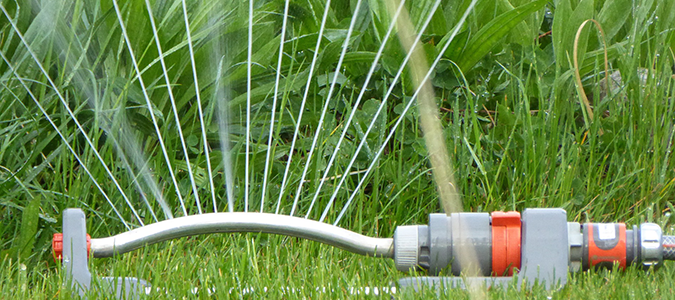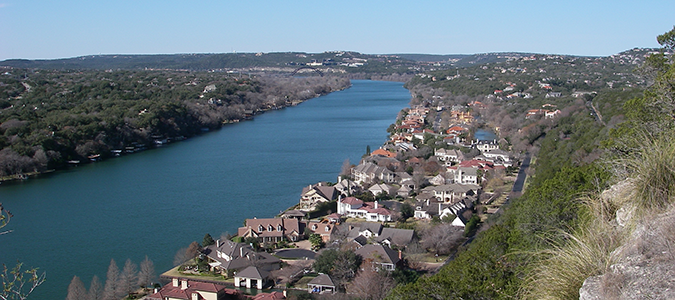
It seems like Austin has switched places with Portland or Seattle this year. We’ve received record amounts of rainfall. And along with the rains, we’ve enjoyed cooler temperatures and a later summer than normal. You’ve heard it on the news – the lakes are full, hurray!
Despite the rain, the City of Austin is still enforcing water restrictions, and has made some long-term changes to reduce water use in the Central Texas area. So if the lakes are full and our water supply is back to previous levels, why are we still operating under water restrictions?
How Austin-Area Water Sources Work Today
Our primary water source in Austin comes from the Colorado River and the system of Highland Lakes along the river. The Lower Colorado River Authority (LCRA) manages this water source, and the City of Austin is its customer.
There are five dams along the river and six lakes created by those dams.
Lake Buchanan (the first lake) and Lake Travis (the second-to-last lake) serve as storage facilities for water. Their levels can fluctuate dramatically during droughts and heavy rainfall – that’s why the level of Lake Travis gets referenced on the news. The remainder of the lakes ((Inks, LBJ, Marble Falls, and Austin) serve as pass-throughs for water flow.
Mansfield Dam, the last in the succession of five dams, is the only one with the ability to hold back floodwaters. The floodgates at Mansfield Dam opened on April 25th, 2016, for the first time in nine years.
The management of this water supply is critical to providing Austin-area residents with water. The lakes are all dependent on both rainfall and water coming in from upstream, and this area has been in an official drought since 2008. That’s almost eight years of drought conditions!
This drought is approaching the conditions of the worst drought in Central Texas history, which occurred between 1947 and 1957.
3 criteria LCRA considers for drought comparisons
- If it’s been over 24 months since Lakes Travis and Buchanan were full. Until recently these lakes were last full in March of 2008, which as of June 2016 was more than 86 months ago.
- If the amount of water flowing into these two lakes is less than it was before the 1947-1957 drought. According to Austin Water, low water inflows in the last few years “shattered records from previous droughts.”
- If the water stored in the above-mentioned lakes falls below 600,000 acre-feet** (or 30%). Lakes fell to 637,000 acre-feet (or 32%), so this was the only criteria of the three not met.
**An acre-foot is a measure of water that equals the amount of water needed to cover an acre of land at a foot deep. It is equal to about 326,000 gallons of water.
So droughts have occurred historically and may happen again in the future. The City of Austin “has the responsibility to ensure that the citizens of Austin have an adequate and safe water supply—which includes making every effort to conserve that water supply,” according to Austin Water’s Understanding the Drought.

It is also important to understand the City of Austin’s agreement with the Lower Colorado River Authority (LCRA). The LCRA has both firm and interruptible customers. Firm customers are entities like cities and industrial plants that need a constant, reliable source of water. Interruptible customers are generally farmers – their water use can be decreased during droughts to meet the needs of firm customers.
As a firm customer, The City of Austin negotiated an agreement with the LCRA in 1987, and that agreement was amended in 1999. The agreement grants the City of Austin run-of-river rights and additional water of up to 325,000 acre-feet per year through 2050. The key thing to understand is that the City of Austin has prepaid $100 million for this water use, and additional water use will generate additional fees. So the City of Austin has a financial motivation to continue to reduce water use.
Efforts to conserve water have been in motion for many years.
In 2006, the City of Austin created the Water Conservation Task Force, consisting of a handful of city officials. The initial goal before the task force launched was to reduce peak daytime water use by 1% for ten years.
The Water Conservation Task Force recommended 20 actionable programs to reduce water use. These programs included varied strategies, from water leak detection and loss to watering restrictions and increased rates. Based on the implementation of these programs, the City of Austin then adopted a goal of 140 gallons per capita daily (GPCD) of water use by 2020.
According to Jason Hill of the City of Austin, this goal has already been reached. And in recent developments, council members voted to make Stage 2 water restrictions permanent, and then voted to move to the Conservation stage water restrictions.
The recent rains may seem like they would signal a relaxation of water restrictions in Austin. However, the City of Austin’s long-term plans to conserve water and recent votes from city council indicate that water restrictions will remain at similar levels for the foreseeable future. Another drought could be on the horizon. If that day comes, the City of Austin is taking strides to conserve water and be as prepared as possible.